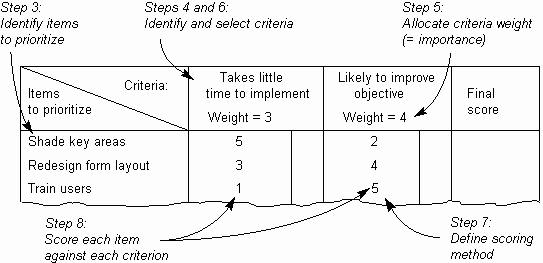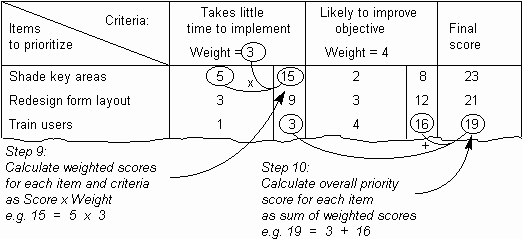Prioritization Matrix: How to do it
The Quality Toolbook >
Prioritization Matrix > How to do it
When to use it | How to understand it |
Example | How to do it | Practical
variations
<-- Previous |
Next -->
How to do it
- Identify the overall objective. For example, 'Increase the profitability of the umbrella product line'.
- Gather the people who are to work on the problem. They should, between them, understand the problem area and how items on the list may be judged.
- Produce the list of items to be prioritized. This may be done using other tools, such as Brainstorming or Surveys.
- Identify a list of criteria which may be used to judge how well each item on the list from step 3 serves the objective from step 1. This may be a fairly long list, but is reduced in steps 5 and 6.
Approaches to identifying criteria may include:
- Analyze the statement of objectives (e.g. What are the components of profit?).
- Identify practical constraints (e.g. How easy is it to do?).
- Consider the benefits, costs and risks.
- Aim for criteria that can be measured objectively and easily, rather than subjectively or with difficulty.
Word the criteria such that it is clear that agreeing with them is desirable. Thus use 'Low cost of ownership', rather than 'Ownership cost'.
- Allocate a weighting number to each criterion to show their relative importance in achieving the overall objective. Thus a criterion with a number of 4 is twice as important as one with a number of 2.
When allocating numbers in a group, if consensus cannot be reached, give each person the same number of points to spread amongst the criteria or use some other Voting method.
- Select the actual criteria to use against the list items to be prioritized. This may be done by:
- Rejecting criteria which have an importance number which is much lower than others.
- Reducing the number of criteria to a small and manageable number, typically around three, by selecting those with the highest importance number.
- Define how the list items from step 3 will be scored against each of the criteria identified in step 6.
Approaches to consider include:
- Have a limited set of possible score values, with associated text to describe what they mean. Thus a score of 4 may mean 'item strongly supports the criterion'.
- Use a Voting system, as in step 5, where each person has a fixed number of points to distribute across items.
- Use negative scores for negative effects. An example is where the criterion is 'reduces manufacturing cost', but the list item actually increases manufacturing cost.
- Use a percentage scale either for direct scoring or to convert the final score into a percentage. This makes it easier to deduce information, for example if one item has a score of 64%, it is clear that all other scores against this criterion total only 36%.
- Score each item against each criterion, using the method identified in step 7, as in the illustration below.
If actual numerical values are available for these comparisons, translate the values into the same score range as identified in step 7. For example, if actual costs are available, but the scoring system uses a total of 100, then divide each cost by the total of all costs and multiply by 100.

Fig. 1. Building the Prioritization Matrix - Multiply each score from step 8 by the number allocated to the appropriate criterion in step 5 to get the weighted score for each item against each criterion, as in the figure below.
- For each item, add up all of the weighted scores from step 8. This gives the final prioritizing score for each item, as in the figure below. The scores may left as they are or converted to percentage values.

Fig. 2. Calculating weighting and final score
- The final list of prioritized items may be made clearer for communication and decision making by sorting it into priority order and displaying it in a Pareto Chart.
<-- Previous |
Next -->
|